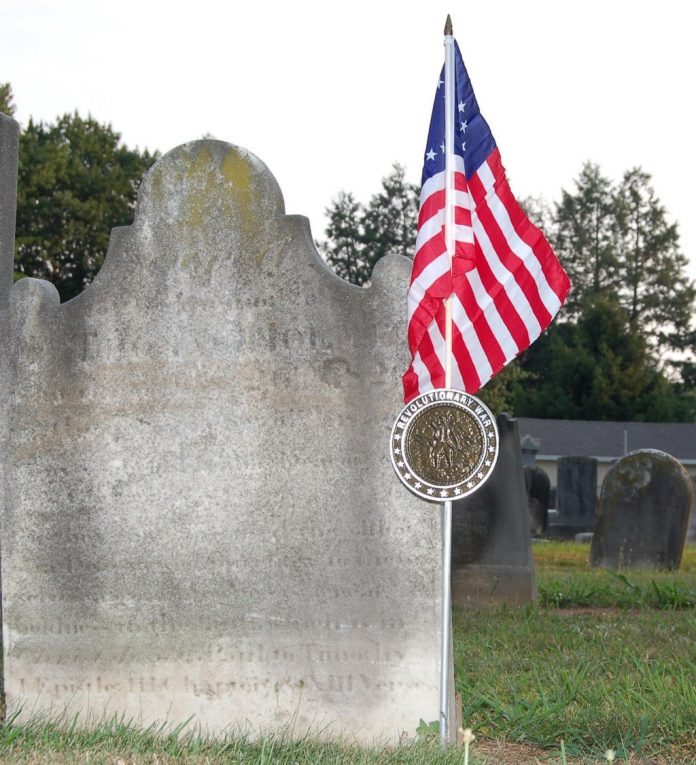A marker was placed at the gravesite of Thomas Holme at the Pennepack Baptist Church on July 6. DONNA DIPAOLO / FOR THE TIMES
During last week’s Northeast History Network event, members adorned the graves of Thomas and John Holme.
A person can learn a lot of interesting, perhaps unexpected, tidbits by attending a meeting of the Northeast Philadelphia History Network.
During a July 6 event at Pennepack Baptist Church, for example, Holmesburg resident Fred Moore revealed that his home neighborhood, contrary to common belief, was not named in honor of William Penn’s surveyor general, Thomas Holme.
Decades after the Colonial-era Thomas Holme mapped out the downtown Philadelphia grid and surrounding counties for William Penn, another likely unrelated Thomas Holme rose to prominence in the area near the confluence of the Pennypack Creek and Delaware River. But he didn’t name Holmesburg, either.
In fact, it was the latter Thomas Holme’s brother, John Holme, who coined the place name — perhaps in recognition of his entire family or maybe in honor of himself alone.
The remains of both American Revolution-era Holme brothers are buried in the church cemetery surrounding Pennepack Baptist, which was erected in 1774 along present-day Krewstown Road, just north of the namesake creek.
During last week’s Northeast History Network event, members adorned the graves of both Holme brothers, as well as six other men, with markers signifying their uniformed Revolutionary War service.
Moore and Joseph Menkevich of Northwood developed the program for the history group in cooperation with Pennepack Baptist and its cemetery caretaker, Tim Unruh.
The historical revelations came fast and furiously.
“That’s exactly the point of this whole thing, learning stuff and putting pieces together,” Moore said.
Longtime Pennepack Baptist member and Northeast historian Pat Stopper noted that the current church building, though 237 years old, wasn’t the congregation’s first. Their first church was built in 1707.
The congregation formed 19 years before that and was the eighth of its denomination in the British-American colonies. It is the seventh-oldest surviving Baptist congregation in the nation.
Pennepack Baptist produced many uniformed members of Washington’s Continental Army, although Pennsylvania as a colony didn’t formally commission militias at the outset of the war due largely to the pacifist Quaker beliefs of its leadership.
John Holme served as a major, and his brother Thomas a captain. Meanwhile, the Edwards brothers — Marshal and Enoch — served in the “flying camp,” a unit of 10,000 reservists from Pennsylvania, Maryland and Delaware who were placed on active duty in mid-1776. Enoch Edwards, a physician, may have been George Washington’s personal doctor.
“There was correspondence” between Dr. Edwards and Washington, Moore said.
Yet two other Pennepack Baptist brothers, Benjamin and Jesse Dungan, also served in the Revolution — Benjamin as a captain. Present-day Dungan Road in the Northeast derives its name from the family.
Fewer military-related records are available about Pennepack Baptist members John Dyre and Samuel Jones, although evidence suggests that both saw active duty during the war. Jones was a minister who was commissioned as a military chaplain and went on to become the longest-serving pastor in the history of Pennepack Baptist.
In addition to placing markers and Betsy Ross flags at the gravesites, the Northeast history group arranged for Revolutionary War re-enactor Tom McHugh, dressed in full battle uniform and gear, to fire three salutatory shots from his flintlock musket.
Unlike stereotypical portrayals of Revolutionary-era fighting men, McHugh did not wear a tri-point hat. Privates didn’t wear that style headgear, he explained.
Offering another interesting factoid, McHugh said that the cliché “flash in the pan” — meaning a spectacle that shines brightly but is short-lived or has little lasting effect — is a direct reference to the firing mechanism in a musket.
It has nothing to do with a fleeting glimmer in a modern-day frying pan, according to McHugh, who offered yet another compelling historical tidbit.
Within days of the July 4, 1776 signing of the Declaration of Independence, its creators had printed a German translation of the text.
“There were so many German immigrants that the Declaration of Independence was printed in two languages,” McHugh said. “German was being considered for the national language, but English won out.”
Pennepack Baptist likely isn’t the only Northeast church with Revolutionary War gravesites. But considering the church’s heritage, it may have the most.
“It could be the largest group. The other big church at the time would’ve been the Byberry Friends. But their gravesites aren’t marked and they were Quakers,” Moore said, noting the denomination’s pacifist doctrine.
Trinity Church Oxford, at Oxford and Longshore avenues, and All Saints Church, at 9601 Frankford Ave., also were in existence during the Revolution. Both were and continue to be Church of England congregations. ••
For information about the Northeast Philadelphia History Network, visit nephillyhistory.com
Reporter William Kenny can be reached at 215–354–3031 or [email protected]





